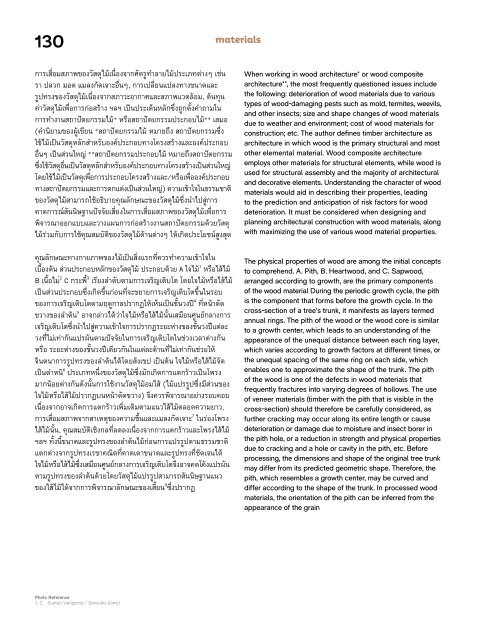ASA JOURNAL 14/2023
Create successful ePaper yourself
Turn your PDF publications into a flip-book with our unique Google optimized e-Paper software.
130<br />
materials<br />
การเสื่อมสภาพของวัสดุไม้เนื่องจากศัตรูทำาลายไม้ประเภทต่างๆ เช่น<br />
รา ปลวก มอด แมลงกัดเจาะอื่นๆ, การเปลี่ยนแปลงทางขนาดและ<br />
รูปทรงของวัสดุไม้เนื่องจากสภาวะอากาศและสภาพแวดล้อม, ต้นทุน<br />
ค่าวัสดุไม้เพื่อการก่อสร้าง ฯลฯ เป็นประเด็นหลักซึ่งถูกตั้งคำาถามใน<br />
การทำางานสถาปัตยกรรมไม้* หรือสถาปัตยกรรมประกอบไม้** เสมอ<br />
(คำานิยามของผู้เขียน *สถาปัตยกรรมไม้ หมายถึง สถาปัตยกรรมซึ่ง<br />
ใช้ไม้เป็นวัสดุหลักสำาหรับองค์ประกอบทางโครงสร้างและองค์ประกอบ<br />
อื่นๆ เป็นส่วนใหญ่ **สถาปัตยกรรมประกอบไม้ หมายถึงสถาปัตยกรรม<br />
ซึ่งใช้วัสดุอื่นเป็นวัสดุหลักสำ าหรับองค์ประกอบทางโครงสร้างเป็นส่วนใหญ่<br />
โดยใช้ไม้เป็นวัสดุเพื่อการประกอบโครงสร้างและ/หรือเพื่อองค์ประกอบ<br />
ทางสถาปัตยกรรมและการตกแต่งเป็นส่วนใหญ่) ความเข้าใจในธรรมชาติ<br />
ของวัสดุไม้สามารถใช้อธิบายคุณลักษณะของวัสดุไม้ซึ่งนำาไปสู่การ<br />
คาดการณ์สันนิษฐานปัจจัยเสี่ยงในการเสื่อมสภาพของวัสดุไม้เพื่อการ<br />
พิจารณาออกแบบและวางแผนการก่อสร้างงานสถาปัตยกรรมด้วยวัสดุ<br />
ไม้ร่วมกับการใช้คุณสมบัติของวัสดุไม้ด้านต่างๆ ให้เกิดประโยชน์สูงสุด<br />
คุณลักษณะทางกายภาพของไม้เป็นสิ่งแรกที่ควรทำาความเข้าใจใน<br />
เบื้องต้น ส่วนประกอบหลักของวัสดุไม้ ประกอบด้วย A ใจไม้1 หรือไส้ไม้<br />
B เนื้อไม้2 C กระพี้3 เรียงลำาดับตามการเจริญเติบโต โดยใจไม้หรือไส้ไม้<br />
เป็นส่วนประกอบซึ่งเกิดขึ้นก่อนที่จะขยายการเจริญเติบโตขึ้นในรอบ<br />
ของการเจริญเติบโตตามฤดูกาลปรากฏให้เห็นเป็นชั้นวงปี 4 ที่หน้าตัด<br />
ขวางของลำาต้น 5 อาจกล่าวได้ว่าใจไม้หรือไส้ไม้นั้นเสมือนศูนย์กลางการ<br />
เจริญเติบโตซึ่งนำาไปสู่ความเข้าใจการปรากฏระยะห่างของชั้นวงปีแต่ละ<br />
วงที่ไม่เท่ากันแปรผันตามปัจจัยในการเจริญเติบโตในช่วงเวลาต่างกัน<br />
หรือ ระยะห่างของชั้นวงปีเดียวกันในแต่ละด้านที่ไม่เท่ากันช่วยให้<br />
จินตนาการรูปทรงของลำาต้นได้โดยสังเขป เป็นต้น ใจไม้หรือไส้ไม้จัด<br />
เป็นตำาหนิ6 ประเภทหนึ่งของวัสดุไม้ซึ่งมักเกิดการแตกร้าวเป็นโพรง<br />
มากน้อยต่างกันดังนั้นการใช้งานวัสดุไม้อมไส้ (ไม้แปรรูปซึ่งมีส่วนของ<br />
ใจไม้หรือไส้ไม้ปรากฏบนหน้าตัดขวาง) จึงควรพิจารณาอย่างรอบคอบ<br />
เนื่องจากอาจเกิดการแตกร้าวเพิ่มเติมตามแนวไส้ไม้ตลอดความยาว,<br />
การเสื่อมสภาพจากสาเหตุของความชื้นและแมลงกัดเจาะ 7 ในร่องโพรง<br />
ไส้ไม้นั้น, คุณสมบัติเชิงกลที่ลดลงเนื่องจากการแตกร้าวและโพรงไส้ไม้<br />
ฯลฯ ทั้งนี้ขนาดและรูปทรงของลำาต้นไม้ก่อนการแปรรูปตามธรรมชาติ<br />
แตกต่างจากรูปทรงเรขาคณิตที่คาดเดาขนาดและรูปทรงที่ชัดเจนได้<br />
ใจไม้หรือไส้ไม้ซึ่งเสมือนศูนย์กลางการเจริญเติบโตจึงอาจคดโค้งแปรผัน<br />
ตามรูปทรงของลำาต้นด้วยโดยวัสดุไม้แปรรูปสามารถสันนิษฐานแนว<br />
ของไส้ไม้ได้จากการพิจารณาลักษณะของเสี้ยน 9 ซึ่งปรากฏ<br />
When working in wood architecture* or wood composite<br />
architecture**, the most frequently questioned issues include<br />
the following: deterioration of wood materials due to various<br />
types of wood-damaging pests such as mold, termites, weevils,<br />
and other insects; size and shape changes of wood materials<br />
due to weather and environment; cost of wood materials for<br />
construction; etc. The author defines timber architecture as<br />
architecture in which wood is the primary structural and most<br />
other elemental material. Wood composite architecture<br />
employs other materials for structural elements, while wood is<br />
used for structural assembly and the majority of architectural<br />
and decorative elements. Understanding the character of wood<br />
materials would aid in describing their properties, leading<br />
to the prediction and anticipation of risk factors for wood<br />
deterioration. It must be considered when designing and<br />
planning architectural construction with wood materials, along<br />
with maximizing the use of various wood material properties.<br />
The physical properties of wood are among the initial concepts<br />
to comprehend. A. Pith, B. Heartwood, and C. Sapwood,<br />
arranged according to growth, are the primary components<br />
of the wood material During the periodic growth cycle, the pith<br />
is the component that forms before the growth cycle. In the<br />
cross-section of a tree’s trunk, it manifests as layers termed<br />
annual rings. The pith of the wood or the wood core is similar<br />
to a growth center, which leads to an understanding of the<br />
appearance of the unequal distance between each ring layer,<br />
which varies according to growth factors at different times, or<br />
the unequal spacing of the same ring on each side, which<br />
enables one to approximate the shape of the trunk. The pith<br />
of the wood is one of the defects in wood materials that<br />
frequently fractures into varying degrees of hollows. The use<br />
of veneer materials (timber with the pith that is visible in the<br />
cross-section) should therefore be carefully considered, as<br />
further cracking may occur along its entire length or cause<br />
deterioration or damage due to moisture and insect borer in<br />
the pith hole, or a reduction in strength and physical properties<br />
due to cracking and a hole or cavity in the pith, etc. Before<br />
processing, the dimensions and shape of the original tree trunk<br />
may differ from its predicted geometric shape. Therefore, the<br />
pith, which resembles a growth center, may be curved and<br />
differ according to the shape of the trunk. In processed wood<br />
materials, the orientation of the pith can be inferred from the<br />
appearance of the grain<br />
Photo Reference<br />
1-2. Suntan Viengsima / Sansuda Jiamjit


















